Intel's 10nm Cannon Lake and Core i3-8121U Deep Dive Review
by Ian Cutress on January 25, 2019 10:30 AM ESTStock CPU Performance: Rendering Tests
Rendering is often a key target for processor workloads, lending itself to a professional environment. It comes in different formats as well, from 3D rendering through rasterization, such as games, or by ray tracing, and invokes the ability of the software to manage meshes, textures, collisions, aliasing, physics (in animations), and discarding unnecessary work. Most renderers offer CPU code paths, while a few use GPUs and select environments use FPGAs or dedicated ASICs. For big studios however, CPUs are still the hardware of choice.
All of our benchmark results can also be found in our benchmark engine, Bench.
Corona 1.3: Performance Render
An advanced performance based renderer for software such as 3ds Max and Cinema 4D, the Corona benchmark renders a generated scene as a standard under its 1.3 software version. Normally the GUI implementation of the benchmark shows the scene being built, and allows the user to upload the result as a ‘time to complete’.
We got in contact with the developer who gave us a command line version of the benchmark that does a direct output of results. Rather than reporting time, we report the average number of rays per second across six runs, as the performance scaling of a result per unit time is typically visually easier to understand.
The Corona benchmark website can be found at https://corona-renderer.com/benchmark
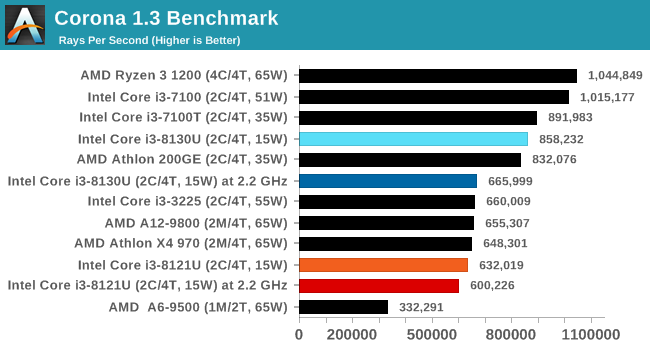
Corona is an AVX2 benchmark, and it would appear that the Cannon Lake CPU can't take full advantage of the functionality. There's still a 10% difference at fixed frequency.
Blender 2.79b: 3D Creation Suite
A high profile rendering tool, Blender is open-source allowing for massive amounts of configurability, and is used by a number of high-profile animation studios worldwide. The organization recently released a Blender benchmark package, a couple of weeks after we had narrowed our Blender test for our new suite, however their test can take over an hour. For our results, we run one of the sub-tests in that suite through the command line - a standard ‘bmw27’ scene in CPU only mode, and measure the time to complete the render.
Blender can be downloaded at https://www.blender.org/download/
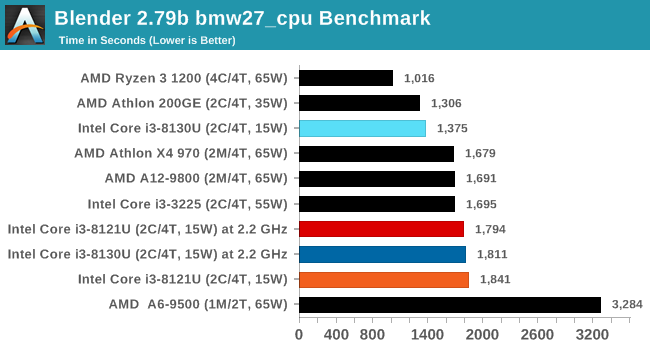
Blender also uses an AVX2 code path, and we see that the CNL processor scored worse at stock settings than at fixed frequency settings. Again, this is likely due to a power or thermal issue.
LuxMark v3.1: LuxRender via Different Code Paths
As stated at the top, there are many different ways to process rendering data: CPU, GPU, Accelerator, and others. On top of that, there are many frameworks and APIs in which to program, depending on how the software will be used. LuxMark, a benchmark developed using the LuxRender engine, offers several different scenes and APIs.
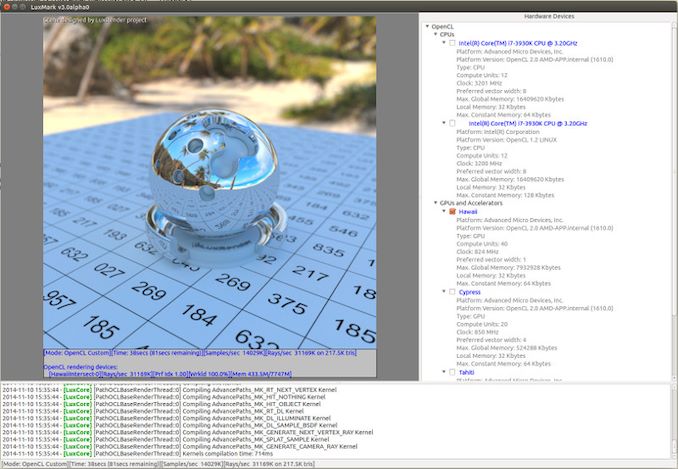
Taken from the Linux Version of LuxMark
In our test, we run the simple ‘Ball’ scene on both the C++ and OpenCL code paths, but in CPU mode. This scene starts with a rough render and slowly improves the quality over two minutes, giving a final result in what is essentially an average ‘kilorays per second’.
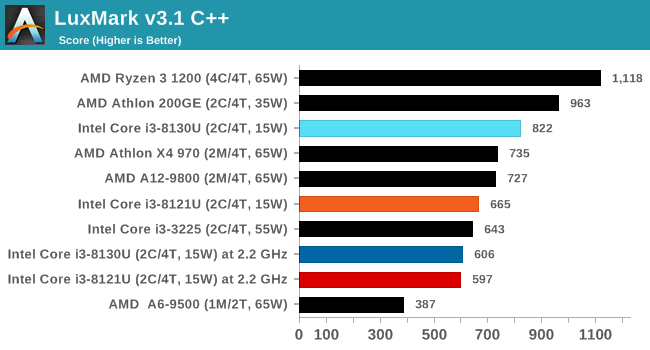
POV-Ray 3.7.1: Ray Tracing
The Persistence of Vision ray tracing engine is another well-known benchmarking tool, which was in a state of relative hibernation until AMD released its Zen processors, to which suddenly both Intel and AMD were submitting code to the main branch of the open source project. For our test, we use the built-in benchmark for all-cores, called from the command line.
POV-Ray can be downloaded from http://www.povray.org/
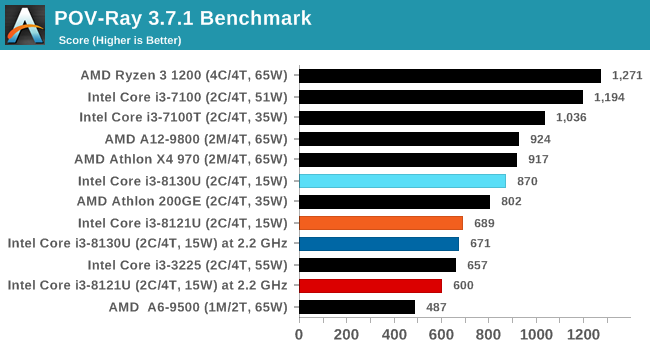











129 Comments
View All Comments
jjj - Friday, January 25, 2019 - link
Bored with laptops, want a large foldable phone with a projected keyboard so i can forget about these bulky heavy things. Ok, fair enough, glasses are way better but those will take a while longer.eastcoast_pete - Friday, January 25, 2019 - link
@Ian: Thanks for the deep dive, and giving the references for background! One comment, three questions (they're related): In addition to being very (overly) ambitious with the 10 nm process, I was particularly struck by the "fused-off integrated graphics" and how Intel's current 10 nm process apparently just won't play nice with the demands in a GPU setting. Question: Any information or rumors on whether that contributed to AMD going the chiplet route for Ryzen going forward? In addition to improving yields, that also allows for heterogeneous manufacturing nodes on the same final chip, so that can get around that problem. Finally, any signs that Intel may go down that road in its upcoming mainstream chips? Any updates on what node they will make their much-announced dGPUs on? Probably won't be this or a related 10 nm process.Lastly, and maybe you and Andrei can weigh in on that: TSMC's (different) 7 nm process seems to work okay for the (smaller) different "iGPUs" in Apple's 12/12x, Huawei's newest Kirin and the new Snapdragon. Any insight/speculation which steps of Intel's 10 nm process cause the apparent incompatibility with GPU usage scenarios?
Thanks!
Rudde - Saturday, January 26, 2019 - link
AMD has lauched huge 7nm desktop graphics cards (2 server and Radeon VII). AMD does not seem to have any problems making gpus on TSMC 7nm.eastcoast_pete - Sunday, January 27, 2019 - link
That's why I asked about the apparent incompatibility of GPU-type dies with Intel's 10 nm process. Isn't it curious that this seems to be the Achilles heel of Intel's process? I wonder if their future chips with " iGPU" will use a chiplet-type approach, with the CPU parts in 10 nm, and the GPU in 14 nm++++ or however many + generations it'd be on. The other big question is what process their upcoming high-end dGPU will be in Unless, Intel let's TSMC make that for them, too.velanapontinha - Friday, January 25, 2019 - link
Every time I read Kaby G I'm instantly stormed by a Kenny G theme stuck in my head, and it ruins the rest of my day.Please stop.
skis4hire - Friday, January 25, 2019 - link
"Fast forward several months later, to May 2018, and we still had not heard anything from Intel."Anton covered their statement in April, where they indicated they weren't shipping volume 10nm until sometime in 2019, and that they would instead release another 14nm product, whiskey lake, in the interim.
https://www.anandtech.com/show/12693/intel-delays-...
Yorgos - Friday, January 25, 2019 - link
>AMD XXXXX (XM/XT, XXW)Thanks Ian for reminding us is every article, that we are reading a Purch media product, or a clueless editor.
Don't forget, 386 was o 0 core CPU.
No, it doesn't bother me as a reader, it bothers me as an engineer who designs and studies digital circuits. But hey you can't have it all, it's hard to find someone who is capable at running windows executables AND know his way in comp. arch..
Ryan Smith - Friday, January 25, 2019 - link
While I'm all for constructive feedback, I have to admit I'm not sure what we're meant to be taking from this.Could you please articulate in more detail what exactly is wrong with the article?
KateH - Saturday, January 26, 2019 - link
i interpreted it as,...
"I disagree with the distinction between 'modules' and 'cores' that is made when some journalistic endevours mention AMD's 'Construction' architecture microprocessors. I find the drawing of a line based on FPU counts inaccurate- disengenous even- given that historic microprocessors such as the renowned Intel 80386 did not feature an on-chip FPU at all, an omission that would under the definitions used by this journalist in this article cause the '386 to be described as having 'zero cores'. The philosophical exercise suggested by such a definition is, based upon my extensive experience in the industry of digital circuit design, repugnant to my sensibilities and in my opinion calls into question the journalistic integrity of this very publication!"
...
or something like that
(automatically translated from Internet Hooligan to American English, tap here to rate translation)
Ryan Smith - Saturday, January 26, 2019 - link
"tap here to rate translation"5/5 stars. Thank you!